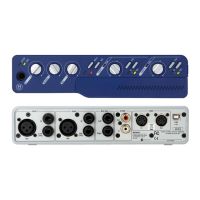Getting Started with Mbox54
Master Faders
Master Faders are used as output and bus mas-
ters, and can control any mono or stereo output
or bus path in a session. You can then use the
controls on the Master Fader to control the vol-
ume, solo and mute, or apply inserts to those
paths.
When you are mastering your final mix, it is rec-
ommended that you use a dither plug-in on the
Master Fader controlling your main outputs (for
more information on dither, see the Pro Tools
Reference Guide).
To create a Master Fader:
1 Choose File > New Track and specify 1 mono
or stereo Master Fader track, then click Create.
2 In the Mix window, click the Master Fader’s
Output Selector and choose the output path
that you want to control. You can choose either
outputs or internal busses.
To use a Master Fader as a master stereo volume
control for all tracks in a session:
1 Choose File > New Track and specify 1 stereo
Master Fader track, then click Create.
2 Set the outputs of all audio tracks in the ses-
sion to outputs 1–2 and set the panning of each
track.
3 Set the output of the Master Fader to your
main output path (outputs 1–2).
Plug-Ins
Plug-ins provide EQ, dynamics, delay, and
many other types of effects processing, and
function either in real time or in non-real time.
RTAS plug-ins are nondestructive effects, which
are inserted on tracks to process audio in real
time—just like an external hardware processor
(during playback).
AudioSuite plug-ins are destructive effects that
process and create new audio files on disk in
non-real-time. (AudioSuite plug-ins can also be
used nondestructively, leaving the original, un-
processed audio file on disk.)
Master Fader controlling main outputs
Dither plug-in applied to final mix
Output assigned to control
main mix

